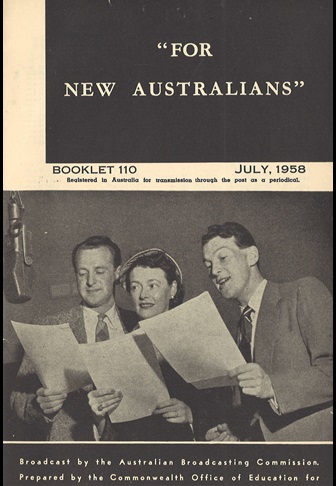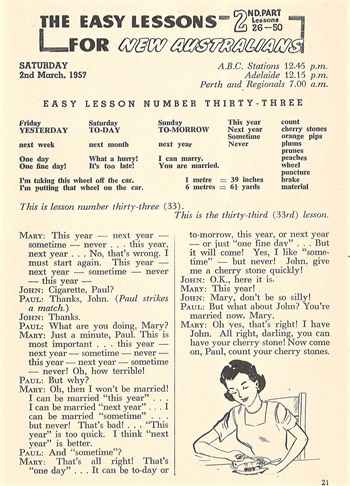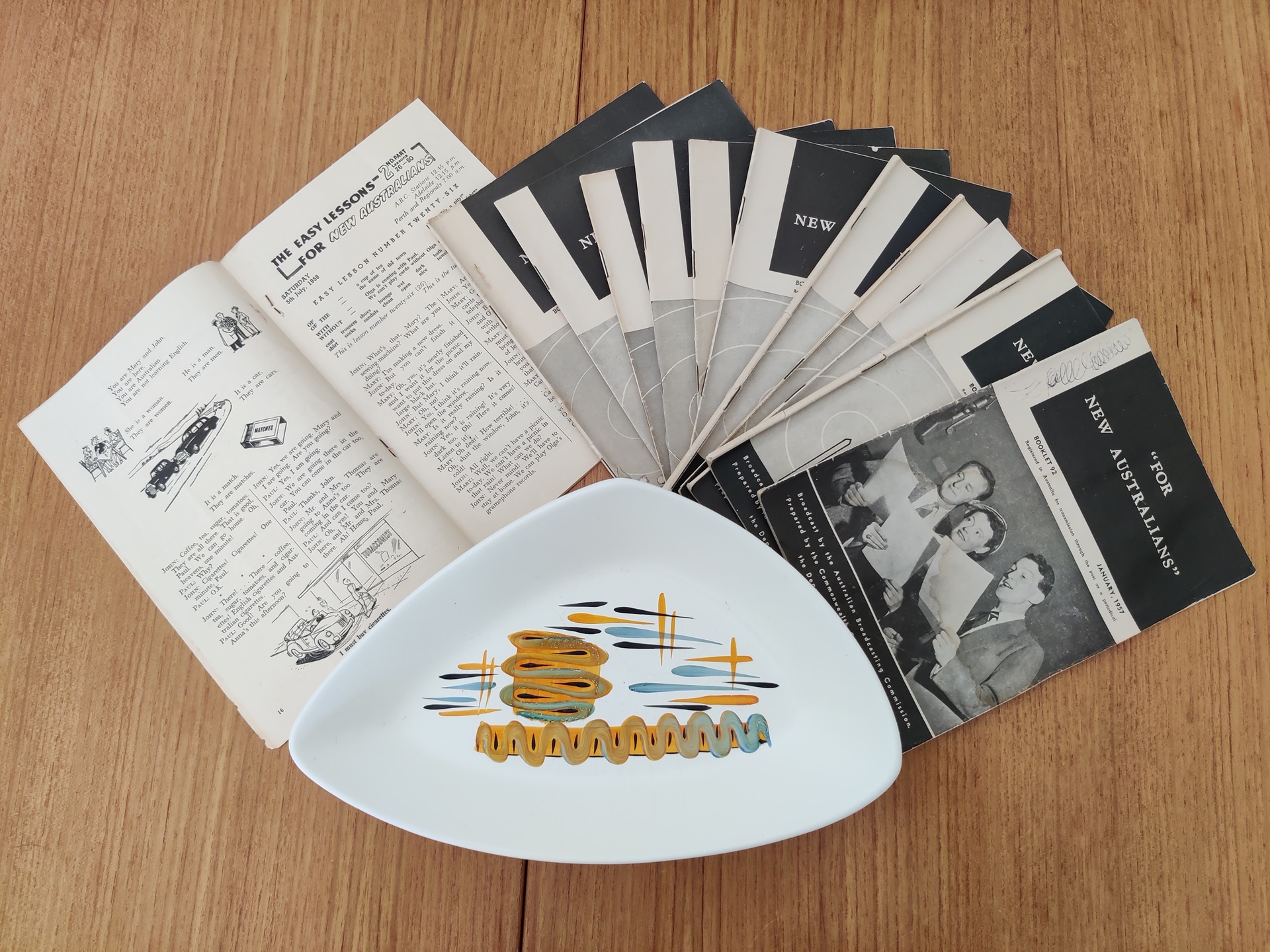
You have arrived in a country that you have only heard about.
You walk out from the ship and glance around, seeing many unfamiliar sights – trees that look strange and people who look different. You go to the shops and can hear people talking all around but you do not understand a word that they are saying. How would you feel? What would you do?
This was the reality for many non-English speaking migrants who arrived in Australia during the 1950s. Following World War II, a sea of non-English speaking migrants landed on Australian shores, signifying a major shift in Australia’s immigration policies.
With the arrivals of non-English speaking migrants, the Australian government encountered a problem of teaching them English. The Department of Immigration enlisted the aid of the Department of Education to create English language programs which would aid assimilation into Australian life. English language instructors taught in the Reception and Training Centres where migrants were temporarily placed.
Migrants could also attend continuation classes that ran in any town where six or more migrants wanted to learn English. These classes took place in the evening and were taught by the local school teacher. Migrants who experienced difficulties attending the class due to distance, work commitments or insufficient class numbers could sign up for correspondence courses.
Those who selected this type of schooling were required to nominate an English-speaking supervisor who would assist them with correct pronunciation and practice conversations.
Radio English lessons were also aired weekly on the ABC. Individuals could fill in the form below and sign up for the monthly booklets and follow along with the live broadcast to learn spoken English.
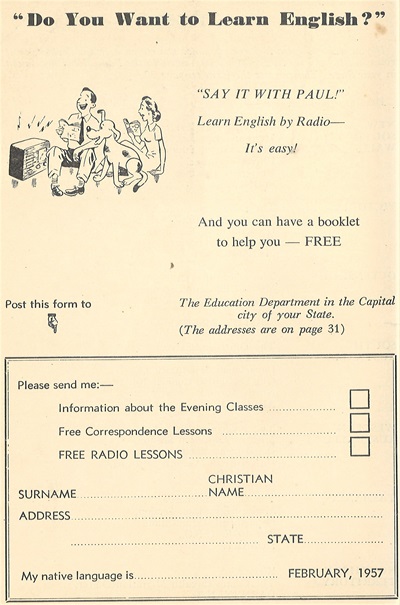
Radio lessons
“For New Australians” was a series of booklets that corresponded with the lessons broadcast live through the ABC. These radio booklets were prepared by the Commonwealth Office of Education for the Department of Immigration.
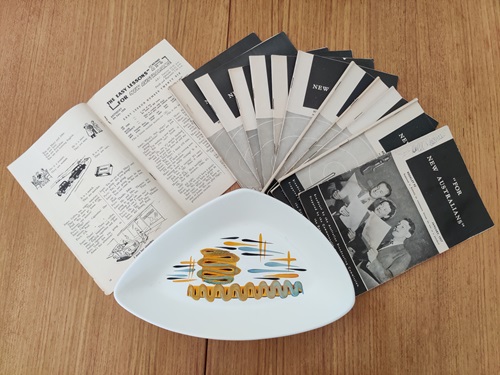
The aim of these lessons was to help European migrants learn the English language, which would allow them to assimilate more easily into Australian life. Although the live radio broadcast changed formats throughout the years, the essence of the programme to teach English remained the same. The booklet was divided into two sessions, ‘Very Easy Lessons’ and ‘Harder Lessons’ which allowed listeners to select the classes that suited their needs.
A total of 75 scripts were created for this programme, with the content broadcast in rotation. Each radio lesson was self-contained, providing greater accessibility for new migrants to join the programme at any time.
In the radio broadcast, the character dialogues were spoken in simple colloquial English which contrasted the formal voice of the announcer, emphasising to the listeners of important points to the lesson. Examples of three of these dialogues have been recorded from the original scripts and can be heard on Soundcloud:
For New Australians, issue 92, January 1957, p. 7.
For New Australians, issue 92, January 1957, pp. 18–20.
For New Australians, issue 108, May 1958 pp. 18–19.
The light-hearted scripts followed the life of Paul, a newly arrived Australian who was learning English through the help of many people in the fictional town of Telora. Although there were many additional characters in the booklets, two other key participants were John and Mary, a married Australian couple who became good friends with Paul.
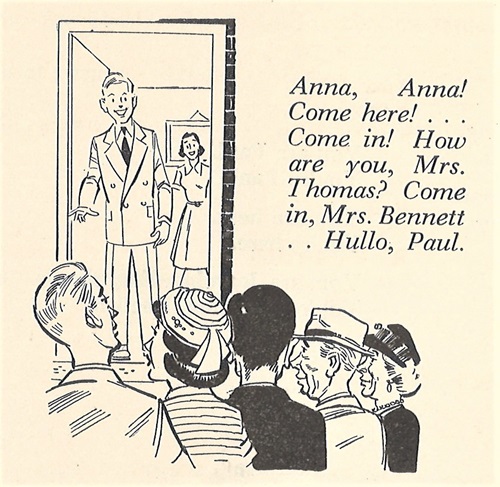
The characters of Mary and John were created with the intention of illustrating to listeners that Australians were friendly people with a desire to help them learn English.
Newspaper advertisements for the programme further highlighted the government’s desire for Australians to display a more welcoming attitude towards immigrants. A comment made by a radio critic in a newspaper from the 1950s implored people to be more considerate of European migrants:
All New Australians from Europe are trying to cope with our language. If you stop to think a little you will have no difficulty in being convinced that the English language is a tough proposition to adults who have never tackled it before.
The author of these booklets was Elvira Hogg, who worked for the Commonwealth Office of Education for 20 years. She was involved in teaching migrants in Australia and worked in the Benalla Migration Centre where she was the chief instructor of teaching English to adults.
Elvira was passionate about teaching English and empathetic to the language barriers that immigrants faced. Using her extensive knowledge of teaching English language to migrants, she became the scriptwriter for the radio booklets until 1970. By this time, the radio lessons had become less relevant with rising popularity of television.
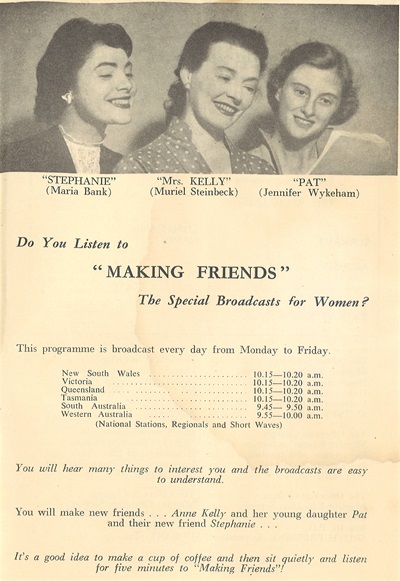
Who was Missing?
The gradual dismantling of the White Australia policy from 1958 finally allowed for a greater intake of non-European immigrants. Although the influence of this policy was waning prior to this time, the booklets’ illustrations and dialogues showed the types of people who were perceived to be “Australian”.
All of the characters in For First Australians are characteristically white. The immigrant characters Paul, Stanislaw and Olga were strictly from European countries, subtly showing the continued impact of the White Australia policy. Off-handed dialogues about a person’s characteristics also perpetuated the idea of the White Australia.
This was far different from the realities of migrant population in Australia. Under strict exemption rules of the Immigration Restriction Act 1901 and Australia’s humanitarian efforts to help refugees, the 1950s and 1960s witnessed an influx of Chinese immigrants.
While the proportion of Australians born overseas in 1957 was 15%, today it is 30%.
Despite the limited representation of the diverse migrant population in the “For New Australians” radio booklets, this series provides a window into a life that appears vastly different from our society today.
Now let’s practice with Paul.
Listen carefully – then SAY IT WITH PAUL
I am Australian.
You are Australian.
We are all Australians
Nandar Lin is a history student from the University of Sydney who researched the “For New Australians” booklets as part of a project for the museum.
If you would like to view some original For New Australians booklets, please drop a line to the museum’s Vaughan Evans Library
